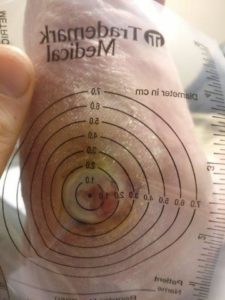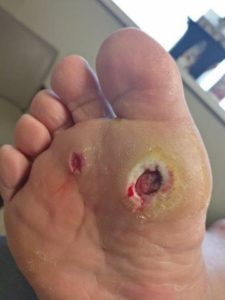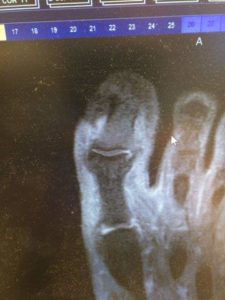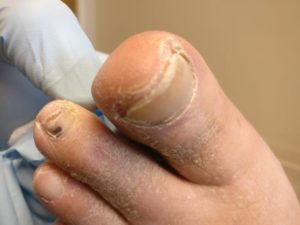What a Podiatrist Can Do For YOU!
Diabetic Foot Ulcer Treatment [Causes, Symptoms & Best Supplies]
Diabetic foot ulcer treatment is best treated by a podiatrist and foot specialist 95%. Don’t put your leg at risk, get your leg healed immediately and seeing a podiatrist as fast as you can!
Table of Contents
Podiatrist Diabetes Ulcer Treatment:
Podiatrist & Foot Doctor Diabetes Foot Ulcer Treatment:
🦶Do you have Diabetic foot pain? This may be the start of a Diabetic Foot Ulcer. We go over the Diabetic Foot Ulcer Early Signs, Causes & BEST Home Treatments🦶
How to treat a diabetic foot ulcer:
0:00 What is a diabetic foot ulcer?
0:53 Diabetic foot ulcer causes
1:08 Diabetic foot ulcer beginnings
2:55 Diabetic foot ulcer infection treatment
3:17 Diabetic foot ulcer stages
3:47 Diabetic foot ulcer podiatrist and diabetic foot ulcer doctors
4:27 Diabetic foot ulcer early signs
4:44 Infected diabetic foot ulcer treatment
5:10 Diabetic foot ulcer treatment at home
5:45 Diabetic foot ulcer total contact cast
6:30 Diabetic foot ulcer shoes
6:45 Diabetic foot ulcer orthotics
7:20 Diabetic foot ulcer exercises and Diabetic foot ulcer stretches
9:08 Early stage diabetic foot ulcer
9:53 Diabetic foot ulcer Home Treatment
10:10 Diabetic foot ulcer Peripheral Neuropathy
What is a diabetic foot ulcer?
- A diabetic foot ulcer is a sore on the bottom of your foot that occurs at some point in almost 25% of all diabetic patients throughout their life.
- The most common site for a diabetic ulcer is on your foot.
- Many of these people become hospitalized due to an infection or an ulcer, or related complications.
- Diabetes and blood flow disease has been called the number one cause of foot or leg amputation in the United States.
- Some patients who develop a full ulcer, if untreated, can progress to amputation. Those people with diabetes who do receive amputation are almost always preceded by diabetic foot ulceration.
- Research has shown that working with a podiatrist is one of the single best things to prevent your foot.

Causes of a Diabetic Foot Ulcer:
- if you have diabetes, there is a strong chance that you can sometimes develop a foot ulcer throughout your life if you do not take the right precautions.
- Studies do show that certain populations and backgrounds are more likely to develop an ulcer. The single most common demographic is older men. This includes Native Americans, Hispanic, and African-American populations.
- Patients who are advanced diabetics who need to use insulin are at the highest risk of developing a full ulcer. This is especially true if you have diabetes-related issues such as kidney, eye, and heart disease.
- A diabetic foot ulcer is also strongly correlated to both being overweight and using alcohol.
- The two biggest associated health conditions to being a diabetic are smoking and the use of alcohol.
- Diabetic foot ulcers almost always start diabetic foot infections

Hard skin can develop in pressure areas of the foot. This can lead to an ulcer with cracks and fissures.
Diabetic Foot Care Prevention
- Most Diabetic foot ulcers are formed due to a combination of numerous factors: the most common of these is the lack of feeling in your foot, poor blood flow down to your foot, foot deformities, constant rubbing or pressure, as well as how long if it had diabetes. Most diabetic patients with foot ulcers first begin to lose sensation in their feet. This is a condition called peripheral neuropathy. This is then combined with rising blood sugar levels that can sometimes be well over 200. The tricky thing about diabetes is that you do not feel the wound coming on, so the patient is usually not aware of the formation of the diabetic foot ulcer. This is the perfect time to see your podiatrist as a week and check for the lack of sensation and show you strategies to be aware of this.
Diabetic toe sores are the most common type of diabetic foot ulcer.
- The second thing that can be done is the valuation of your foot care. You must make sure that you are wearing the right things every day. Things as simple as the stitching in your sock or the stitching on the inside of your shoe can easily cause a diabetic foot ulcer to develop.

This is where surgery can be especially effective. Reducing the high arch and combining it with good shoes and orthotics can relieve a significant amount of pressure.
How to make a wound heal faster?
- Studies showed that seeing a foot-in-wound specialist such as a podiatrist is one of the single most effective things you can do. Don’t worry.
- The single best thing you can do is evaluate and make sure that you are doing nothing wrong. For example, I mean that some people are usually missing one essential criterion that is necessary to healing.
- This means looking out for the basics.
- The four basics are evaluating your blood flow to make sure you have excellent blood flow, making sure your blood sugar is low and under control, making sure that you are not putting any pressure on your foot, and finally making sure that you don’t have an infection.
- The single biggest mistake in treating foot ulcers is relying on products.
- The biggest waste of time is focusing only on expensive products such as stem cells or expensive creams.
- Sure they are helpful in a comprehensive treatment plan, but we see tons of people doing everything wrong, but then trying to apply an expensive cream and hoping for magical results.
- The true way to heal a diabetic foot ulcer is to make sure you have the four basics in place.
- If you can do these four things well, you are almost guaranteed to heal your wound, but easier said than done!
- Don’t fall into the commercialized trap of buying better and more expensive products and not doing the cheap, easy, and proven basics to be affected by hard science.

How to treat a diabetic foot ulcer:
The four basics:
Great blood flow:
- See your podiatrist get your blood flow evaluating. This is called your arterial brachial index. This is an easy screening test that can be performed and is usually the first test order.
- Your podiatrist will check your blood flow to your dorsalis pedis and your posterior tibialis arteries. If your blood flow is reasonable, this is the single biggest criterion in your foot ulcer. If you have some blockage, if you are a smoker, if you are a long-term diabetic, your podiatrist will work with a vascular surgeon to optimize your blood flow.
- This is a crucial and essential step. In our opinion, this is the single biggest thing that can be done for most patients with chronic nonhealing ulcers.
Get your diabetes under control:
- This is another area where your podiatrist and primary care doctor can work together in terms of optimizing your healing rate. We often have patients with ulcers, and saying all my blood sugar is normal at 200, this is not normal! If your blood sugar is anything over 120 on average, this will severely compromise your healing ability.
- It is 100% necessary to get your blood sugar as normal as possible to have any chance of healing your ulcer. Don’t fall for the gimmicks. Care products will not work if you do not have blood flow and blood sugar averages over 120. These are the single biggest and easiest things you can do to correct the underlying reasons for why you have an ulcer.
Make sure you don’t have an infection:
- This is an area where your podiatrist can work with an infectious disease doctor. If you have any redness around your wound or drainage from the center of your wound, you likely have an infection of the current. In the short term, it is essential to start taking antibiotics and to get antibiotic medication onto this site. This can be life-threatening if allowed to continue for lengthy periods of time without improving.
- If you have redness or drainage developing around your ulcer, don’t waste any time, this is the single most urgent thing you can do, don’t be someone who loses their leg because they waited one or two days too long.

Take the pressure off the diabetic foot ulcer:
- Once you meet the first three criteria for wound healing, this is where podiatrists will really get you to close up your wound as quickly as possible. If you have great blood flow if your diabetes is well-controlled, and if you don’t have an infection, the next best thing is to take pressure off the wound site.
- Once you meet all four of these criteria, the wound rapidly can close for you. That may sound simple when I write it like this, but harder said than done! Most people with foot ulcers have had a hard time staying off of it and are not in the world’s best physical condition. For example, you can’t just hop around 1 foot for a month or two until the wound heals, and it’s usually not an option to just lay in bed for a month or two.
- This is where special equipment like offloading orthotics, good shoe gear, ankle-foot braces, diabetic shoes, and diabetic inserts. Once you’re able to offload the level, most of our patients have pretty rapid healing. In our clinic, patients a day with rooms on their feet, and if we get their feet offloaded and meet the four criteria, I outlined, almost every patient reaches rapid.
Diabetes Foot Care Tips:
🦶Do you have diabetes & diabetic foot pain? We go over the BEST Diabetic Foot Treatment: Manage Diabetic Foot Symptoms & Prevent Diabetic Foot Ulcers!🦶
0:00 Diabetic Foot Treatment
0:46 Diabetic Foot Podiatrist
1:00 Diabetic Foot Symptoms
1:15 Diabetic Foot Exam
1:35 Diabetic Foot Soaks
2:00 How to soak diabetic feet
2:25 Diabetic foot self assessment at home
2:40 Diabetic Foot Infection
2:55 Diabetic foot socks
3:18 Diabetic foot shoes
3:50 Best Diabetic slippers
4:10 Best Diabetic Shoes
4:35 How to fit a diabetic shoe
4:50 Diabetic foot orthotics
5:05 Diabetes and poor blow flow
5:50 Diabetic foot nerve pain
6:21 Diabetic Foot Peripheral Neuropathy
6:35 Diabetic foot ulcer prevention
6:50 Diabetic foot home remedies and home diabetic foot prevention
Podiatrist & Foot Doctor Treatment:
- Toenail Fungus Treatment (Oral or Laser ).
- Toenail Trimming.
- Orthotics Fitting.
- Ingrown Toenails.
- Infected Ingrown Toenails.
- Podiatrist pedicure or medical pedicure.
- Trimming of Corns, Trimming of Calluses, and Treatment of Pressure Blisters.
- Diabetic Foot Care & Diabetic Foot Wounds.
- Athletes Foot, Dry Skin, Eczema.
- Foot & Ankle Ulcer Care.
- Infection and Abscess Care.
- Staph Infections in the Toe or Foot Treatment.
- Treatment of Plantar Warts for Your Toes and Feet.
- Foot & Ankle Injections (Steroid or Natural Solutions.)
- Management of Foot & Ankle Fractures (Walking Boots for broken toes or broken feet).
- Heel Pain (Heel Spur or Plantar Fasciitis).
- Custom Orthotics for children and adults (In the office).
- Over the Counter Orthotics for children and adults.
- Podiatrist medical pedicure.
- Extra-Depth Shoes for Patients with Diabetes.
- Diabetic Shoes.
- Gout Treatment.
- Prescription (Refills).
- Telehealth appointments.
- Shockwave therapy (AKA ESWT or EPAT therapy)
- Cold laser therapy (In the office).
- MLS laser therapy (Multi-Wave Locked System laser therapy).
- Laser for peripheral neuropathy (In-Office).
- Senior Toenail Cutting & Toenail Trimming Services.
Frequently Asked Podiatrist Questions?
Q: What is a podiatrist?
A: Podiatrists are Doctors of Podiatric Medicine, DPM. Podiatrists are podiatric physicians, foot doctors, or podiatric surgeons. Podiatrists often diagnose and treat the foot, ankle, and other related structures of the leg.
Podiatrists receive similar training that other doctors complete. They complete four years of training in a podiatric medical school and three years of hospital residency training.
The podiatrists at Prime Foot & Ankle Specialists have received extra training, such as fellowships beyond residency and board certifications by the board of foot and ankle surgery and the board of podiatric medicine.
Q: Do podiatrists accept insurance?
Yes, podiatrists do, except for insurance. We set most major insurance plans as podiatrists and foot doctors. This includes Medicare, Medicare plus blue, Blue Cross Blue Shield, United Health, and Aetna health. Humana, Blue Care Network, Oscar Health, Molina, Meridian, Health Alliance Plan of Michigan (HAP), Health Share Plans, Christian Health Share Plans, Worker’s Compensation Plans, and Cigna Healthcare.
Q: Is podiatrist toenail trimming covered by insurance?
Yes, this service may be covered for people with help issues that cannot help themselves. If your foot is in pain or has a health issue, a podiatrist is recommended to evaluate you, and this is a covered option.
If you have foot pain, please call our office and schedule a no-obligation consultation with our podiatrists to assess your eligibility for foot care.
Q: Does insurance cover podiatrist ingrown toenail removals?
Yes, ingrown toenails are covered by insurance. Let us help! Don’t wait to come in if you have a toe or foot infection.
Q: What parts of the body do podiatrists treat?
A: Podiatrists in Michigan are licensed to treat the foot, ankle, and lower leg below the knee.
At Prime Foot & Ankle Specialists, we specialize in toenail problems, toe problems, foot problems, heel problems, ankle problems, minimally invasive surgery, advanced diagnostic techniques, and advanced treatment options. We pride ourselves on being your choice for all foot and ankle problems!
Q: When should I call a podiatrist for an appointment?
A: Pain is never normal, especially if it lasts longer than a week. This means that most insurance plans will cover a visit if you feel you have a problem developing with your feet.
The longer you wait, the more serious the pain may become, leading to hospitalization or further foot problems.
It would help to have it evaluated and treated to avoid long-term problems.
Q: Can podiatrists perform corn removal and callus removal?
A: Corns and calluses are thick, hardened layers of skin. Development of corn and callouses occur when your skin tries to protect itself against friction and pressure.
If corns and calluses are causing you discomfort, you should seek treatment. The most common areas of development are on your feet and toes. We provide treatment for these somewhat unsightly painful conditions. Don’t hesitate to contact us today.
Q: Does insurance cover the podiatrist treatment of corns and calluses:
If you feel you have a foot problem that you cannot care about on your own, evaluation and diagnosis are covered. We provide a no-obligation consultation to inform you if this is the case. In general, foot pain and a painful lesion on the foot covered the visit.
Q: What is a hammertoe?
A: A Hammertoe is a contracture (bending) of one or both joints of the second, third, fourth, or fifth toes.
We provide advanced imaging such as ultrasound and digital X-rays to diagnose immediately in the office.
This abnormal bending can pressure the toe when wearing shoes, causing painful problems.
Conservative and surgical treatment options are available for the treatment of Hammertoes.
Q: What causes heel pain?
A: Typically, heel pain is not caused by one single incident or injury, and the most common cause is plantar fasciitis, which can lead to long-term pain that may one day require surgical treatment if not corrected.
Repetitive stress/pounding of the heel can cause heel pain.
Other common causes can include inflammation of the plantar fascia, inflammation of the back of the heel, inflammation of the heel pad, progressive degeneration of the Achilles tendon, or a stress fracture caused by repetitive stress to the heel.
Q: What are orthotics or insoles?
A: Orthotics or insoles are custom foot supports that replace the over-the-counter supports that come in shoes you buy off the shelf at the store. These are designed to hug your foot more efficiently than over-the-counter products to significantly aid in balancing the biomechanical inadequacies of your feet and legs.
Q: How can you tell if you have an infected ingrown toenail?
A: You may have an infected ingrown toenail if there are any signs of redness, swelling, pain, and drainage, such as puss coming from the area.
- If you notice any of these symptoms, contact your podiatric Physician immediately.
- If you have toenail pain, this may also be a sign. It is never normal to have toenail pain.
- If you have toenail redness or swelling, this is never normal.
Q: What is plantar fasciitis that causes heel pain?
A: The plantar fascia is the thick connective tissue on the bottom of the foot.
- This tissue connects the heel bone to the toes and is responsible for creating the arch in your foot.
- Plantar fasciitis is inflammation of the plantar fascia.
Q: Does Medicare pay for diabetic shoes and custom orthotics?
A: Medicare will cover diabetic shoes and inserts for some patients.
- Patients must meet and have specific qualifying conditions verified by the Physician managing their diabetes.
- If you have diabetes, you should have an annual foot evaluation performed by a foot doctor or podiatrist to determine your eligibility for this benefit through Medicare and other insurance carriers.